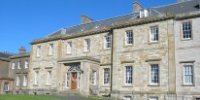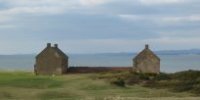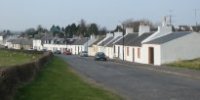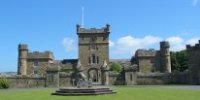Monktown and Prestick
[Vol. XII, pages 394–403]
(County of Ayr, Synod of Glasgow and Ayr, Presbytery of Ayr)
By the Rev. Andrew Mitchell, D.D.
Name, Extent
The parish receives its name from the manor–place of Monktown, which, before the Reformation, is reported to have been a religious convent pertaining to the abbacy of Paisley, from which the village, and many of the farms had their names. This manor and barony have now the mane of Orangefield, and had formerly a jurisdiction of regality.
[395] The parish, at present, extends in length from the N where it adjoins the parish of Dundonald, and Symington upon the NE, 3¼ miles towards the S where it is bounded by the parish of Newtown and St Quivox. From the E where it borders upon Tarbolton and Craigie, 3 miles in breadth; but in other parts, beyond the Pow–burn, scarce above half that measure. On the W it is bounded by the Frith [sic] of Clyde, opposite to the island of Arran. The village and church of Monktown are distant from the sea about a mile. The prospect is agreeable and pleasant, and the air salubrious. Seldon andy epidemical diseases prevail, but such as are common. The village contains about 34 dwelling–houses, and 46 families, and is intersected by 3 toll–roads; one leading from Ayr to Irvine, another to Kilmarnock and Glasgow, and the third to Tarbolton and St Quivox.
Church of Monktown, Burgh of Prestick, &c
The church of Monktown is an old fabric; no person alive can give any account when it was built. The burgh of Prestick [396] contains about 66 dwelling–houses, and 266 persons, 53 of whom are under 7 years of age. There are 36 freeholders in the burgh, whose freeholds, at present, are reckoned, at an average, at 50s yearly, with a privilege of pasturage for 72 soums of sheep upon the common, 5 sheep being reckoned to a soum. Sometimes poinds are driven and executed at the cross of Prestick. A freeman, when incarcerated, cannot be [397] confined with locked doors; but if he comes out, he loses his freedom, unless liberated by the judicial sentence of the magistrates. None can sell their freedom but to the community, who have the power to sell it to whom they please, upon paying the agreed price. Males and females equally succeed to the freeholds, in which their charter differs from that of Newtown, renewed much about the same time. The kirk of Prestick still stands, and is an old fabric that subsisted in the time of Popery. The walls are thick, and supported with stone–buttresses at the E end; is distant from the sea less than a quarter of a mile, and much exposed to the storms. From it, there is a beautiful prospect of the Crag [sic] of Ailsa, the Heads of Ayr, and the Frith of Clyde, where the ships from Greenock, Saltcoats, and Irvine, are frequently passing outward and inward bound; and it serves as a land–mark for ships at sea. Divine service was performed in this church before the disjunction and the erection of Newtown, every third Sunday, for the most part; but the burgh of Newtown having obtained a separate erection for themselves, the necessity is superseded, Prestick church being no more than 1 English mile from Monktown, and the parish church at present being as centrical [sic] as could be well devised.
Patron, Stipend
Patron, Robert Reid, Esq. of Adamton. The stipend of Monktown, Prestick, and Crosby, consists of 50 bolls bear, 29 bolls e firlots mean, £25 5s 33/12d Sterling, to which the Lords Commissioners of Kirks and Tiends have added, by decreet of augmentation, lately obtained, 4 chalders, half meal, half bear, with £5 Sterling for communion elements, besides manse and glebe.
Soil
The soil of Monktown and Prestick is, in general, fruitful, diversifyed [sic] in its quality. Upon the E and highest [398] part of it, it is an earthy clay, in the middle, deep and loamy, and, as it approaches the sea, is sandy and benty downs, that answer for the pasturing of young cattle; and, from the saltness of the water, and warmth of the climate, judged conducive to the recovery of weak sheep. Snow and frost are of shor duration in the winter, and the pasture open. The grounds are mostly enclosed with ditch and hedge in the Monktown part of the parish, and properly subdivided into parks, with extensive belts of planting. In Prestick, the enclosures are few, the soil sandy, and the tenure by which they hold their freedoms unfavourable for such improvement, being subject of a revolution every 19 years, when, by a rule now established, they are to cast lots for the respective freedom each freeman is to possess, The soil is better toward the E, where it joins the Newtown loch and St Quivox. The lower part next the village produces crops of rye, oats, and bear, which are good in wet seasons. The soil there is found good for crops of potatoes, and might produce turnip. The most of the enclosing and planting has been made within these 60 years, and there are people still alive, who remember when it began. The ground rents paid by the tenants, at present, are generally from 25s to 35s and 40s the acre, and some pay more. Grass lets at 21s 25s and some 30s the acre. The soil being light rich mould, naturally runs into grass and white clover, when fallow. Before enclosing, some people remember, that the highest rent for croft land was 10 merks Scots; and outfield 2s 6d or 3s 4d Sterling.
Agriculture, &c
The cultivation is usually e years oats, then bear or barley laid down with grass–seeds, sometimes pease and beans, and afterward a crop of oats. When the ground is laid down with grass–seeds, or, after cutting 1 or 2 years, in hay, it usually lies in ley 4 or 6 years. The [399] farmers generally use 3 horses, with a plough after the English form, and some use only 2 horses. The usual time of sowing, is about the middle of March, and beginning of April; and bear or barley about the middle of May; reaping in August and September; hay harvest in June and July. The manure used by the farmers near the sea, who have the privilege, is sea ware, remarkable for raising crops of sown–grass, and crops of bear or barley; but does not meliorate above 2 years: They also use lime, of which they have no quarries, but but and drive at the distance of 3 or 4 miles. There are not above 3 freestone quarries in the parish, which increases the price of building considerably: and, as yet, no coal–mines have been found; but there are appearances that indicate that such may be found in process of time, and will undoubtedly turn out to great advantage, as lying near the sea. The quantity of natural wood, is 36 acres, besides large plantations.
There are no rivers in the parish; but there are 3 rivulets: 1. The Pow–burn, over which there is one bridge, on the toll–road leading from Monktown to Ayr, and another lately begun to be erected on the road to St Quivox and Tarbolton. The other 2 rivulets are called the Rumbler–burn, and Fall–burn, which all run into the sea, and in summer are mostly dry. At present, there is only 1 mill in the parish for grinding grain, and another for flac, kept by the same miller. Few are astricted [sic] to it, the farmers being at liberty to carry their grain to any mill they please, without being oppressed with multures, which are a great discouragement to agriculture.
The usual produce after milling oats, is 18, 19, and 20 pecks the Winchester boll, now the standard measure of this country. The amount of oats milled by the different farmers in Monktown and Prestick, by an account given by themselves in the year 1791, was 1315 bolls; and bear sold, and [400] otherwise disposed of, 399 bolls. The oats, bear, and barley, are reckoned to be of the best quality, and bring a high price in the market. There is little wheat sown, through in most places the soil is sufficiently strong, and when sown, produces good crops. The culture of turnips is only beginning to be introduced. One farmer has sowed 6 or 7 acres, and finds his account in it, by feeding black cattle for the market, and preparing the soil for bear and wheat, and likewise sending them to the market of Ayr. Potatoes are mostly planted for family use, and reckoned to amount to about 23 or 24 acres in the whole parish at present, about 13 in Monktown, and 10 in Prestick.
Population
According to Dr Webster's report, the number of souls in 1755, was 1163. In Monktown there are 6 heritors, 3 of whom reside.
|
Examinable persons |
567 |
Average of baptisms |
20 |
|
Below that age |
150 |
Marriages |
7 |
|
|
717 |
Deaths |
10 |
The present calculation will not correspond to Dr Webster's, as that account was given to him before the disjunction and erection of Newtown. That the population is greatly increased, cannot be doubted, as the farms have been divided into small proportions, and new farm houses built. There have been built, 8 new houses in Monktown village, and 4 new farm houses, besides 2 cotton houses for hand jennies, 1 of them for 9, the other for 6, which employs a considerable number of hands within these few years.
[401]
Trades
In Monktown, are
|
House–wrights |
2 |
Tailors |
2 |
|
Cart and plough wrights |
2 |
Cooper |
1 |
|
Weaver |
1 |
Excise officer |
1 |
|
Mason |
1 |
Tobacco manufacturers |
2 |
|
Shoemakers |
4 |
Public houses |
5 |
|
Blacksmith |
1 |
Feuars |
16 |
In Prestick, are
|
Weavers |
16 |
Blacksmith |
1 |
|
Stockingmakers |
2 |
Public houses |
2 |
|
Wrights |
4 |
New built houses within these 7 or 8 years |
13 |
|
Mason |
1 |
|
|
Farm houses in the whole parish 37, including 4 gentlemens seats, who all have farms in their own hands.
Rent
The valued rent of the whole parish, including Newtown, is £1755 18s Scotch money. The real rent of Monktown and Prestick, is supposed to be between £1800 and £2000.
School
There is an established school for teaching english, writing, arithmetic, and church music. The salary is very small, being only £100 Scots, with a house and garden. 40 scholars usually attend for 3 quarters of the year; the other quarter being diminished by the seed–time and harvest work. The wages for teaching are very small, being 1s 6d a quarter ofr reading, 2s for writing, 3s for arithmetic and church music.
[402]
Antiquities, &c
At Low Monktown hill, 3 quarters of a mile from the church, near the farm house, situated upon a rising ground, a large stone is placed. Upon digging for materials for making a road, several urns containing human bones were found, There is no tradition how they were deposited, if it was not in the time of the Romans, when Julius Agricola commanded, who was said to have sent Roman forces into that part of the country, with the view of invading Ireland. About a quarter of a mile E from the church, upon a rising ground, stands a handsome sepulchral monument, erected to the memory of Governor McCrae, formerly governor of Madras in the East Indies, which is now the burying-place of Mr Dalrymple of Orangefield. Upon the estate pf Ladykirk, belonging to Alexander Gardiner, Esq there are some remains of a chapel, dedicated to the Virgin Mary, called in old writings, Ladykirk in Kyle, situated in the common pasture lands of Adamtown, being a part of that barony belonging formerly to the family of Blair, who had the right of patronage in the times of Popery. The building was a square, and turrets placed upon each corner; the chapel placed in the middle. One of the turrets still remains, which some time ago was repaired. The whole is enclosed in the garden at present. When digging, [403] many human bones were found, as probably, the burying–place was nigh to it. There is a beautiful prospect from it of the country around, and the western sea. Nigh Prestick, upon the toll–road to Ayr, is situated Kincase [sic], or King's Case, a charitable institution in the time of Popery.




